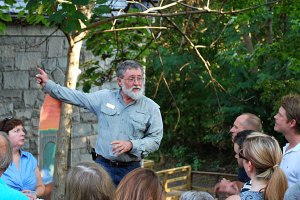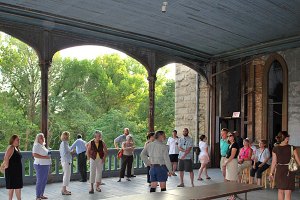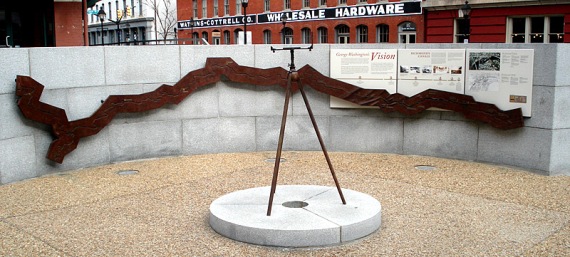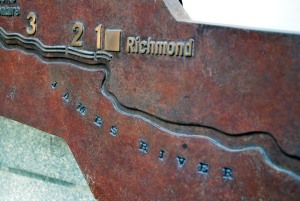 It is rare when “architecture” and “James River” can be used in the same sentence. That is the unique appeal of the Pump House.
It is rare when “architecture” and “James River” can be used in the same sentence. That is the unique appeal of the Pump House.
I tagged along with the Historic Richmond Foundation‘s Quoit Club on a tour of the Victorian Gothic treasure, which is located in the Byrd Park District, west of the Boulevard Bridge on the Kanawha Canal. It was designed and constructed in the 1880s under the leadership of the great Richmond city engineer Col. Wilfred Emory Cutshaw.
A description of its original functions from the National Park Service:
A municipal industrial building whose purpose was to house the Richmond city waterworks. The building, which served as the city’s waterworks from 1883 until 1924, is conveniently situated to draw water from the James River and Kanawha Canal as well as its own smaller canal. The facility pumped water uphill from the canals to the Byrd Park Reservoir, the city’s main water supply. Far from being entirely utilitarian, however, the pump house was also a popular gathering place in the late 19th and early 20th centuries.
 Park manager Ralph White was the official sponsor of the tour, teaming with Chris Hull of the James River Outdoor Coalition and Tricia Pearsall of the Friends of the James River Park to guide and educate the crowd of nearly 50 people on an hour-long tour of the park and the ancient civic landmark.
Park manager Ralph White was the official sponsor of the tour, teaming with Chris Hull of the James River Outdoor Coalition and Tricia Pearsall of the Friends of the James River Park to guide and educate the crowd of nearly 50 people on an hour-long tour of the park and the ancient civic landmark.
The Pump House has been under renovation for the past decade, mostly by volunteers. Hull explained that the Pump House had been in disrepair for years. Vandals had been breaking in and stealing, burning and smashing whatever they could get their hands on. Eventually, a hole in the roof threatened to destroy the building.
Volunteers donated their time and more than $40,000 to repair the roof, block the windows with plexiglass and to purchase lumber used to build walkways and staircases to improve visitor access.
“The work has been done by people like you that care,” White said to the Quiot Club crowd. “It is one of the most lovely buildings left in the city…the last thing of beauty owned by the city, after they sold City Hall…It captures the essence of what it is to be in Richmond.”
 A dramatic feature of the Pump House is the old open-air dance floor — an open space with a balcony above the pump room on the top floor of the building. Many of the Quiot Club members took in the view and wondered about the storied high society events that took place there in the late 1880s and early 1900s before the automobile replaced batteau boats and the need for the Pump House diminished.
A dramatic feature of the Pump House is the old open-air dance floor — an open space with a balcony above the pump room on the top floor of the building. Many of the Quiot Club members took in the view and wondered about the storied high society events that took place there in the late 1880s and early 1900s before the automobile replaced batteau boats and the need for the Pump House diminished.
The plan is that it will one day make its grand return as the new home for the park system visitor’s center or a James River museum. It could also be a learning center, host weddings, parties, meetings, events and the batteau rides on the Kanawha Canal could again be a feature.
 Though the Pump House is “still considered a stabilized ruin,” according to White, the inside of the building has passed safety inspections and has had some lighting added, though more is needed. An elevator and running water to the building are next, which could cost an estimated $75,000, according to White.
Though the Pump House is “still considered a stabilized ruin,” according to White, the inside of the building has passed safety inspections and has had some lighting added, though more is needed. An elevator and running water to the building are next, which could cost an estimated $75,000, according to White.
The Pump House has already played host to a few events. White said the best story was an “unwedding” — a jilted bride-to-be had a party with all her girlfriends toasting good riddance to her fiance who supposedly cheated on her. There was also a ghost hunting event in March, though White said he didn’t plan to encourage more events like that one in the future.
 The architectural plans have been drawn, but funding is the next big step, White said. The project could call for more than $8.5 million. The most costly items could be shoring up leak the canal walls above the Pump House to stop leaks; enclosing the building to add air conditioning and heat; and installing utilities, including water and power.
The architectural plans have been drawn, but funding is the next big step, White said. The project could call for more than $8.5 million. The most costly items could be shoring up leak the canal walls above the Pump House to stop leaks; enclosing the building to add air conditioning and heat; and installing utilities, including water and power.
“If the city is going to compete with the surrounding counties, it’s the preservation of our abundant historic resources that makes living in the city worthwhile,” White said.
A renovated Pump House could ideally be “an extension of the museums on the Boulevard,” White said, noting that respected public landmarks like The Carillon, Dogwood Dell and Maymont are all in the neighborhood. The building could be a hub for information about the James River or even all city parks.
 Renovations could eventually include the park being a key to the Richmond greenways effort, Pearsall suggested. With all of the surrounding bike & hiking trails, the James River and Kanawha Canal flowing through the park, it is the ideal spot for something remarkable to be developed.
Renovations could eventually include the park being a key to the Richmond greenways effort, Pearsall suggested. With all of the surrounding bike & hiking trails, the James River and Kanawha Canal flowing through the park, it is the ideal spot for something remarkable to be developed.
Want to be involved? Contact the James River Outdoor Coalition (JROC), Friends of the James River Park or contact director J.R. Pope and his people in the Department of Parks, Recreation & Community Facilities.
This was the Quiot Club’s first visit to the Pump House and my first official chance to meet face-to-face with members — many of whom said they have been reading this blog. Here’s what they are all about:
Named for Richmond’s most popular 19th century social club, the Quoit Club is Richmond’s premiere organization for people who enjoy experiencing history and architecture with a social twist. Today, the Quoit Club supports Historic Richmond Foundation’s mission to preserve the area’s unique heritage by promoting social and educational gatherings at historic sites.
 WHAT: “George Washington’s Vision” at the Canal Walk Turning Basin in downtown Richmond, Virginia.
WHAT: “George Washington’s Vision” at the Canal Walk Turning Basin in downtown Richmond, Virginia. ARTIST: Applebaum Associates Inc.
ARTIST: Applebaum Associates Inc.


















Comments & trackbacks